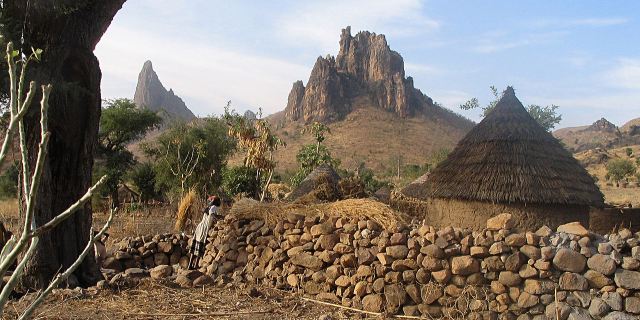Bandjoun (La 'Djo in local language) is a town and commune in the Koung-Khi Department in the West Region of Cameroon. Bandjoun is also the capital of the Koung-Khi department, and one of the largest traditional chefferie (chiefdom) in Bamiléké country. The chief dwells in Hialah, and has many wives.
Its inhabitants speak Ghomala' or Bandjoun which is one of the Bamiléké family of languages.
 Bandjoun Locals
Bandjoun Locals A House in Bandjoun
A House in Bandjoun The Noun River
The Noun RiverThe recent history of the Bandjoun people is relatively well known today. Recent history, however, covers only the last two centuries. Further research on the prehistory of the village Bandjoun is needed. Some existing chronologies cite the foundation of Bandjoun village in the 14th and 15th centuries under the Royal Magistracy of Notchwegom (1525 according to some sources but probably in 1570).
It is now established that King Foudoup was the first King of Baleng who reigned between 1545 and 1573. King Fodoup had difficulty in reconciling his first two sons Tchoungafo and Notchwegom about who would succeed him at his death. He openly expressed a preference for Tchoungafo to which Notchwegom took great umbrage and decided to leave the village of his father to found his own village below in the Noun Valley. Taking care to avoid irritating small chiefdoms that existed in the area, he moved to the edge of the last village where he could finally find free land. It was at the current location of Famleng.
After installing the first encampment at Bandjoun, Notchwegom quickly disappeared. His first wife, with whom he had already had a young son barely a teenager (11 years old according to some), sought the protection of his stepfather until her son, Du'gnechom, would be old enough to succeed his father. King Foudoup used this opportunity to reconcile posthumously with his son by fully supporting his wife and introducing her little son to the art of building royal power.
Du'gnechom in turn, once he was a young adult, became leader of the camp set up by his father at Famleng and quickly developed the qualities of a great hunter and leader. He then married a young woman his mother had prepared for him who quickly gave him a son who he named Notouom. Having taken steps to expand his military to develop his hegemonic pretensions, he instructed his son on his intentions and introduced him to war strategies. Du'gnechom died probably in 1589 when his son Notouom was only 19. Notouom was the first real first level king of Bandjoun and he worked to achieve his father's objectives and expand the village of Bandjoun.
King Foudoup was succeeded by his son Tchoungafo who, in turn, reigned from 1573 to 1628. Tchoungafo installed and inducted Notouom I in 1589 to the Bandjoun throne. He was assured of that office as the successor to his father who was the founder of Bandjoun.
During the long reign of Notouom, which lasted until 1641, he worked to increase the population of Bandjoun by buying all that he could acquire (cattle, food, valuables, and slaves whom he freed to integrate them into his kingdom). It was under his royal magistracy that the name Bandjoun originated with the term Pa Djo meaning "those who buy". Very expansionary, he made all the smaller heads of villages vassals and modernised his kingdom administratively and militarily. He created administrative districts called Djie.
After transferring the seat of the Kingdom of Famleng to Hiala, he stood at the head of the seven districts which were similar to Duchies with a kind of non-feudal Duke called Kemdjie whose sole mission was to monitor the Duchy and pass information collected to the Minister of the Interior called Nwalah Kah. These divisions are still in force today with Famleng, for example, in the district of Djiesse.
There was also a Prime Minister called Nwalah Sissi. He handled all the affairs of the Kingdom and its diplomatic ties.
The Grand venerator exhibited remarkable piety towards God that materialised through the "Si Notouom", a shrine located at Famleng.
The above version of history of Bandjoun was composed based on a comparative historical methodology. Theories that place the founding of Bandjoun before the 16th century are not credible. Research undertaken by historians about the history of the village of Baleng allow the placement of the origins of the village of Bandjoun with less uncertainty.
Notouom I was succeeded by his son Notouom II who consolidated the achievements of the kingdom of his father and strengthened the prestige of Bandjoun in the region. His reign was also long, as well as that of his successor Notouom III.
Since 1589 the enthronement ceremony of the King of Bandjoun is conducted under the patronage of the powerful King of Baleng. The enthronement of the King of Baleng is also conducted under the high magistracy of King Bandjoun. For example, the last enthronement of the new King of Baleng in 2013 was under the powerful patronage of His Majesty Djomo, King of Bandjoun, at the village of Baleng.
In the 18th century an attempt at invasion of Banfjoun was made by the armies of the Sultan of Bamun but it ended in a complete military debacle for Bamun and the Sultan was pursued and besieged at Foumban by King Kamga I who forced him to sign an armistice treaty.
































Add new comment